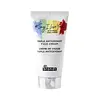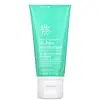What's inside
What's inside
 Key Ingredients
Key Ingredients

 Benefits
Benefits

 Concerns
Concerns

 Ingredients Side-by-side
Ingredients Side-by-side

Water
Skin ConditioningGlycerin
HumectantIsohexadecane
EmollientIsopropyl Isostearate
EmollientPolymethyl Methacrylate
Cyclopentasiloxane
EmollientWine Extract
AntioxidantAloe Barbadensis Leaf Juice
Skin ConditioningRose Extract
Skin ConditioningCeramide NP
Skin ConditioningSucrose
HumectantGlycine Soja Oil
EmollientMineral Salts
Skin ConditioningRosa Centifolia Flower Oil
MaskingPhenoxyethanol
PreservativeBehenyl Alcohol
EmollientCaprylic/Capric Triglyceride
MaskingStearic Acid
CleansingHelianthus Annuus Seed Oil
EmollientStearyl Alcohol
EmollientCetearyl Alcohol
EmollientPEG-100 Stearate
Sodium Acrylates Copolymer
C12-13 Pareth-3
EmulsifyingLecithin
EmollientDimethiconol
EmollientSodium Polyacrylate
AbsorbentEthylhexylglycerin
Skin ConditioningCetearyl Glucoside
EmulsifyingPolyacrylamide
Osmanthus Fragrans Flower Extract
MaskingButyrospermum Parkii Butter
Skin ConditioningDisodium EDTA
Theobroma Cacao Seed Butter
EmollientTheobroma Grandiflorum Seed Butter
Skin ConditioningMangifera Indica Seed Butter
Skin ConditioningSorbitol
HumectantC13-14 Isoparaffin
EmollientCamellia Sinensis Leaf Extract
AntimicrobialAllantoin
Skin ConditioningEugenia Caryophyllus Flower Extract
AstringentButylene Glycol
HumectantPropanediol
SolventLaureth-7
EmulsifyingOxothiazolidine
Skin ProtectingPanthenol
Skin ConditioningVitis Vinifera Seed Extract
Antimicrobial1,2-Hexanediol
Skin ConditioningHydroxyacetophenone
AntioxidantSodium Hydroxide
BufferingTocopherol
AntioxidantXanthan Gum
EmulsifyingSodium Hyaluronate
HumectantOleic Acid
EmollientCI 77491
Cosmetic ColorantWater, Glycerin, Isohexadecane, Isopropyl Isostearate, Polymethyl Methacrylate, Cyclopentasiloxane, Wine Extract, Aloe Barbadensis Leaf Juice, Rose Extract, Ceramide NP, Sucrose, Glycine Soja Oil, Mineral Salts, Rosa Centifolia Flower Oil, Phenoxyethanol, Behenyl Alcohol, Caprylic/Capric Triglyceride, Stearic Acid, Helianthus Annuus Seed Oil, Stearyl Alcohol, Cetearyl Alcohol, PEG-100 Stearate, Sodium Acrylates Copolymer, C12-13 Pareth-3, Lecithin, Dimethiconol, Sodium Polyacrylate, Ethylhexylglycerin, Cetearyl Glucoside, Polyacrylamide, Osmanthus Fragrans Flower Extract, Butyrospermum Parkii Butter, Disodium EDTA, Theobroma Cacao Seed Butter, Theobroma Grandiflorum Seed Butter, Mangifera Indica Seed Butter, Sorbitol, C13-14 Isoparaffin, Camellia Sinensis Leaf Extract, Allantoin, Eugenia Caryophyllus Flower Extract, Butylene Glycol, Propanediol, Laureth-7, Oxothiazolidine, Panthenol, Vitis Vinifera Seed Extract, 1,2-Hexanediol, Hydroxyacetophenone, Sodium Hydroxide, Tocopherol, Xanthan Gum, Sodium Hyaluronate, Oleic Acid, CI 77491
Water
Skin ConditioningAloe Barbadensis Leaf Juice
Skin ConditioningGlycerin
HumectantEthylhexyl Palmitate
EmollientCaprylic/Capric Triglyceride
MaskingGlyceryl Stearate Se
EmulsifyingCetearyl Alcohol
EmollientStearic Acid
CleansingSodium Hyaluronate
HumectantChamomilla Recutita Flower Extract
MaskingCamellia Sinensis Leaf Extract
AntimicrobialAllantoin
Skin ConditioningPanthenol
Skin ConditioningSodium PCA
HumectantArnica Montana Flower Extract
MaskingCalendula Officinalis Flower Extract
MaskingLavandula Angustifolia Flower Extract
CleansingTocopherol
AntioxidantDimethicone
EmollientXanthan Gum
EmulsifyingGlyceryl Laurate
EmollientUndecylenic Glycerides
Phenoxyethanol
PreservativeEthylhexylglycerin
Skin ConditioningWater, Aloe Barbadensis Leaf Juice, Glycerin, Ethylhexyl Palmitate, Caprylic/Capric Triglyceride, Glyceryl Stearate Se, Cetearyl Alcohol, Stearic Acid, Sodium Hyaluronate, Chamomilla Recutita Flower Extract, Camellia Sinensis Leaf Extract, Allantoin, Panthenol, Sodium PCA, Arnica Montana Flower Extract, Calendula Officinalis Flower Extract, Lavandula Angustifolia Flower Extract, Tocopherol, Dimethicone, Xanthan Gum, Glyceryl Laurate, Undecylenic Glycerides, Phenoxyethanol, Ethylhexylglycerin
Ingredients Explained
These ingredients are found in both products.
Ingredients higher up in an ingredient list are typically present in a larger amount.
Allantoin is a soothing ingredient known for its protective and moisturizingg properties. Because of this, it is often added to products with strong active ingredients.
Studies show higher concentrations of this ingredient can promote wound healing.
Though it can be derived from the comfrey plant, allantoin is produced synthetically for cosmetic products to ensure purity.
Learn more about AllantoinAloe Barbadensis Leaf Juice comes from leaves of the aloe plant. Aloe Barbadensis Leaf Juice is best known for helping to soothe sunburns. It is also anti-inflammatory, moisturizing, antiseptic, and can help heal wounds.
Aloe is packed with good stuff including Vitamins A, C, and E. These vitamins are antioxidants, which help fight free-radicals and the damage they may cause. Free-radicals are molecules that may damage your skin cells, such as pollution.
Aloe Barbadensis Leaf Juice also contains sugars. These sugars come in the form of monosaccharides and polysaccharides, folic acid, and choline. These sugars are able to help bind moisture to skin.
It also contains minerals such as calcium, 12 anthraquinones, fatty acids, amino acids, and Vitamin B12.
Learn more about Aloe Barbadensis Leaf JuiceCamellia Sinensis Leaf Extract is derived from the leaves of the tea plant. Black tea, green tea, and oolong tea are all harvested from this plant.
This ingredient has many skin benefits:
This ingredient contains polyphenols, a strong antioxidant. Antioxidants help fight off molecules that damage skin cells.
On top of that, the antioxidants in green tea neutralize free-radicals from the sun. This gives the skin some extra UV protection, but should not replace sunscreen.
Many components of tea have anti-inflammatory properties.
Polyphenols and L-theanine help soothe the skin and reduce irritation. The caffeine in Camellia Sinensis Leaf Extract helps calm inflamed blood vessels.
Other compounds found in tea include: Vitamin Bs, linoleic acid, magnesium, calcium, iron, and zinc.
Research has shown both drinking Camellia Sinensis Leaf Tea and applying it to the skin can help boost skin elasticity and hydration. Studies also show using tea extract may reduce sebum, or oil, production.
Learn more about Camellia Sinensis Leaf ExtractThis ingredient is an emollient, solvent, and texture enhancer. It is considered a skin-softener by helping the skin prevent moisture loss.
It helps thicken a product's formula and makes it easier to spread by dissolving clumping compounds.
Caprylic Triglyceride is made by combining glycerin with coconut oil, forming a clear liquid.
While there is an assumption Caprylic Triglyceride can clog pores due to it being derived from coconut oil, there is no research supporting this.
Learn more about Caprylic/Capric TriglycerideCetearyl alcohol is a mixture of two fatty alcohols: cetyl alcohol and stearyl alcohol. It is mainly used as an emulsifier. Emulsifiers help prevent the separation of oils and products. Due to its composition, it can also be used to thicken a product or help create foam.
Cetearyl alcohol is an emollient. Emollients help soothe and hydrate the skin by trapping moisture.
Studies show Cetearyl alcohol is non-toxic and non-irritating. The FDA allows products labeled "alcohol-free" to have fatty alcohols.
This ingredient is usually derived from plant oils such as palm, vegetable, or coconut oils. There is debate on whether this ingredient will cause acne.
Due to the fatty acid base, this ingredient may not be Malassezia folliculitis safe.
Learn more about Cetearyl AlcoholEthylhexylglycerin (we can't pronounce this either) is commonly used as a preservative and skin softener. It is derived from glyceryl.
You might see Ethylhexylglycerin often paired with other preservatives such as phenoxyethanol. Ethylhexylglycerin has been found to increase the effectiveness of these other preservatives.
Glycerin is already naturally found in your skin. It helps moisturize and protect your skin.
A study from 2016 found glycerin to be more effective as a humectant than AHAs and hyaluronic acid.
As a humectant, it helps the skin stay hydrated by pulling moisture to your skin. The low molecular weight of glycerin allows it to pull moisture into the deeper layers of your skin.
Hydrated skin improves your skin barrier; Your skin barrier helps protect against irritants and bacteria.
Glycerin has also been found to have antimicrobial and antiviral properties. Due to these properties, glycerin is often used in wound and burn treatments.
In cosmetics, glycerin is usually derived from plants such as soybean or palm. However, it can also be sourced from animals, such as tallow or animal fat.
This ingredient is organic, colorless, odorless, and non-toxic.
Glycerin is the name for this ingredient in American English. British English uses Glycerol/Glycerine.
Learn more about GlycerinPanthenol is a common ingredient that helps hydrate and soothe the skin. It is found naturally in our skin and hair.
There are two forms of panthenol: D and L.
D-panthenol is also known as dexpanthenol. Most cosmetics use dexpanthenol or a mixture of D and L-panthenol.
Panthenol is famous due to its ability to go deeper into the skin's layers. Using this ingredient has numerous pros (and no cons):
Like hyaluronic acid, panthenol is a humectant. Humectants are able to bind and hold large amounts of water to keep skin hydrated.
This ingredient works well for wound healing. It works by increasing tissue in the wound and helps close open wounds.
Once oxidized, panthenol converts to pantothenic acid. Panthothenic acid is found in all living cells.
This ingredient is also referred to as pro-vitamin B5.
Learn more about PanthenolPhenoxyethanol is a preservative that has germicide, antimicrobial, and aromatic properties. Studies show that phenoxyethanol can prevent microbial growth. By itself, it has a scent that is similar to that of a rose.
It's often used in formulations along with Caprylyl Glycol to preserve the shelf life of products.
Sodium Hyaluronate is hyaluronic acid's salt form. It is commonly derived from the sodium salt of hyaluronic acid.
Like hyaluronic acid, it is great at holding water and acts as a humectant. This makes it a great skin hydrating ingredient.
Sodium Hyaluronate is naturally occurring in our bodies and is mostly found in eye fluid and joints.
These are some other common types of Hyaluronic Acid:
Learn more about Sodium HyaluronateStearic Acid is a fatty acid. It is an emollient, emulsifier, and texture enhancer.
As an emollient, stearic acid helps soften skin. It aids the skin's protective barrier by preventing water loss. It also provides a gentle cleansing effect without stripping away natural oils.
Stearic acid may also be used to enhance the texture of products. It can add volume and stabilize ingredients such as water and oil. This can help water and oil ingredients from separating.
Sources of stearic acid include animal or vegetable fats/oils such as coconut or shea. It can be naturally found in butter, cocoa butter, shea butter, vegetable fats, and animal tallow.
This ingredient may not be Malassezia folliculitis, or fungal-acne safe.
Learn more about Stearic AcidTocopherol (also known as Vitamin E) is a common antioxidant used to help protect the skin from free-radicals and strengthen the skin barrier. It's also fat soluble - this means our skin is great at absorbing it.
Vitamin E also helps keep your natural skin lipids healthy. Your lipid skin barrier naturally consists of lipids, ceramides, and fatty acids. Vitamin E offers extra protection for your skin’s lipid barrier, keeping your skin healthy and nourished.
Another benefit is a bit of UV protection. Vitamin E helps reduce the damage caused by UVB rays. (It should not replace your sunscreen). Combining it with Vitamin C can decrease sunburned cells and hyperpigmentation after UV exposure.
You might have noticed Vitamin E + C often paired together. This is because it is great at stabilizing Vitamin C. Using the two together helps increase the effectiveness of both ingredients.
There are often claims that Vitamin E can reduce/prevent scarring, but these claims haven't been confirmed by scientific research.
Learn more about TocopherolWater. It's the most common cosmetic ingredient of all. You'll usually see it at the top of ingredient lists, meaning that it makes up the largest part of the product.
So why is it so popular? Water most often acts as a solvent - this means that it helps dissolve other ingredients into the formulation.
You'll also recognize water as that liquid we all need to stay alive. If you see this, drink a glass of water. Stay hydrated!
Learn more about WaterXanthan gum is used as a stabilizer and thickener within cosmetic products. It helps give products a sticky, thick feeling - preventing them from being too runny.
On the technical side of things, xanthan gum is a polysaccharide - a combination consisting of multiple sugar molecules bonded together.
Xanthan gum is a pretty common and great ingredient. It is a natural, non-toxic, non-irritating ingredient that is also commonly used in food products.
Learn more about Xanthan Gum